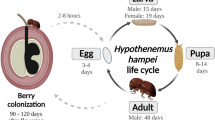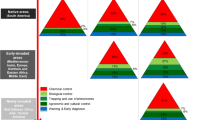Abstract
Different insect species attack cashew flowers during different phenological stages of the inflorescences from 511 to 619 of Biologische Bundesanstalt, Bundessortenamt und Chemische Industrie (BBCH) scale of cashew phenology. A total of 67 species were documented during the investigation between 2016 and 2020. Among all pest groups, Lepidopterans were dominant comprising 32 species followed by Hemipterans with 22 species. The pests newly reported on cashew flowers include Perixera sp., Bombotelia jocosatrix, Gyrtona sp., Gatesclarkeana sp., Ascotis selenaria, Tinolius sp. besides two Cicadellids and two Lygaeid bugs. Damage symptoms, seasonal incidence and natural enemies were also documented for different pests. None of the weather factors had significant relationship with tea mosquito bug (TMB), B. jocosatrix and Lamida moncusalis. Though rainfall had no significant relationship with any of the pest population, number of rainy days had significant negative relationship with apple and nut borer (ANB) (-0.35), beetles (-0.35), thrips (-0.39) and mirids (-0.34). Parasitism by Trathala flavorbitalis on ANB was 15–30%, and by Apanteles sp. on Archips sp. was 20–25%. Reduction in nut set up to 47.06% has been recorded due to inflorescence pests in unsprayed trees compared to sprayed ones under mild infestation of TMB.







Similar content being viewed by others
Data availability
Yes.
References
Adiga JD, Muralidhara BM, Preethi P, Savadi S (2019) Phenological growth stages of the cashew tree (Anacardium occidentale L.) according to the extended BBCH scale. Ann Appl Biol, https://doi.org/10.1111/aab.12526
DCCD (2019) Directorate of Cashew and Cocoa Development, Statistics – cashew, area and Production. https://dccd.gov.in/Content.aspx?mid=1075&tid=1
Desai MA, Kulkarni SV, Rodrigues A (1977) Report on marketing survey on cashew in Goa. Government of Goa, Daman and Diu, pp 11–17
Kumar V, Kumar A, Nath V (2011) Emerging pests and diseases of litchi (Litchi chinensis Sonn.). Pest Manag Horticul Ecosyst 17:11–13
Kumar V, Reddy PV, Anal AKD, Nath V (2014) Outbreak of the Looper, Perixera illepidaria (Lepidoptera: Geometridae) on Litchi, Litchi chinensis (Sapindales: Sapindaceae) - A New Pest Record from India. Florida Entomol 97(1):22–29
Maruthadurai AR, Desai HR, Chidananda Prabhu Singh NP (2012) Insect pests of cashew and their management. Technical Bulletin. No.28. ICAR Research Complex for Goa, Goa. p. 18
Oerke EC, Debne HW, Schonbeck F, Weber A. (1994) Crop Production and Crop Protection. Elsevier, Amsterdam
Peng RK, Christian K, Gibb K (1999) Utilization of green ants, Oecophylla smaragdina to control cashew insect pests. pp 88, a Research Report to Rural Industries Research and Development Corporation, Canberra, Australia.
Peng RK, Christian K, Lan LP, Binh NT (2008) Integrated cashew improvement program using weaver ants as a major component. Manual for ICI program trainers and extension officers in Vietnam. Charles Darwin University and Institute of Agricultural Science for South Vietnam, Vietnam
Prasada Rao GSLHV, Gopakumar CS (1994) Climate and cashew. Cashew 8(4):3–9
Satapathy CR (1993) Bioecology of major insect pests of cashew (Anacardium occidentale Linn.) and evaluation of certain pest management practices. Ph D thesis, UAS, Bangalore, p. 224
Schreiner IH, Nafus DM (1992) Changes in a moth community mediated by biological control of the dominant species. Environ Entomol 21:664–668
Siswanto RM, Muhamad R, Omar D, Karmawati E (2008) Dispersion pattern of Helopeltis antonii Signoret (Hemiptera: Miridae) on cashew plantation. Indonesian J Agric 1(2):103–108
Soumya BR, Verghese A, Kamala Jayanthi PD (2017) Diversity and economic status of Lepidopteran insect-pest on two major varieties of mango. J Entomol Zool Stud 5(3):838–843
Srikumar KK, Bhat PS, Raviprasad TN, Saroj PL (2017) Climate change and cashew pests. In: Saroj PL (ed) Cashew: Improvement, production and processing. Astral International Pvt. Ltd, New Delhi, pp 593–623
Sundararaju D (1993) Compilation of recently recorded and some new pests of cashew in India. The Cashew 7(1):15–19
Sundararaju D (2002) Pests and disease management in India. The Cashew 16(4):32–38
Sundararaju D, (1999a) Screening of cashew accessions to tea mosquito bug, Helopetis antonii Sign. (Heteroptera: Miridae). The Cashew 13(4): 20–26
Sundararaju D (2009) Species composition, yield loss and management of lepidopteran flower and fruit pests in cashew. J Plant Crop 37(1):21–25
Sundararaju D, Raviprasad TN, Bhat PS (1999) Pests of cashew and their integrated management. pp. 525–544. In: IPM System in Agriculture (Eds) Upadhyay, R.K., Mukerji, K.G. and Dubey, O.P., Vol.6. Cash Crops. Aditya Books Pvt. Ltd., New Delhi, India
Sureshkumar RS, Rajabaskar D, Chozhan K, Regupathy A (2004) Harvest time residues of new insecticide lambda cyhalothrin (Karate@5 E.C.) in /on cashew. Pestology 28(6): 75–77
Theilert W (2006) A unique product: The story of the imidacloprid stress shield. Pflsnzenschutz-Nachrichten Science Forum Bayer 59:73–86
Vanitha K, Saroj PL, (2015) Insect pest of cashew and their management. Technical Bulletin 27. ICAR-Directorate of Cashew Research, Puttur, Karntaka, India. p. 61
Walker PT (1992) Quantifying the relationship between insect population, damage, yield and economic thresholds. In: Assessment CL, Management P (eds) Teng. P.S. International Book Distributing Co., Lucknow, India, pp 114–132
Acknowledgement
Authors express their gratitude to Dr. H.M. Yeshwanth, Asst. Professor, Department of Agricultural Entomology, University of Agricultural Sciences, GKVK, Bengaluru, India and Dr. P.K. Shashank, Scientist, Division of Entomology, Indian Agricultural Research Institute, New Delhi, India for identifying the insect specimens and Dr. Ankita Gupta, Senior Scientist, ICAR-National Bureau of Agricultural Insect Resources, Bengaluru, India for identifying the natural enemies. Authors also thank the Director, ICAR-Directorate of Cashew Research, Puttur, Karnataka, India for the support and facilities provided during the study.
Author information
Authors and Affiliations
Contributions
First author conceived the idea of the work, planned the work, recorded data and analyzed the data. Second author recorded part of the pest data.
Corresponding author
Ethics declarations
Competing interests
On behalf of all authors, the corresponding author declares there are no conflicts of interest.
Additional information
Publisher's Note
Springer Nature remains neutral with regard to jurisdictional claims in published maps and institutional affiliations.
Rights and permissions
About this article
Cite this article
Vanitha, K., Raviprasad, T.N. Flower pests of cashew, their seasonal incidence, damage and natural enemies. Int J Trop Insect Sci 42, 163–171 (2022). https://doi.org/10.1007/s42690-021-00527-2
Received:
Accepted:
Published:
Issue Date:
DOI: https://doi.org/10.1007/s42690-021-00527-2




